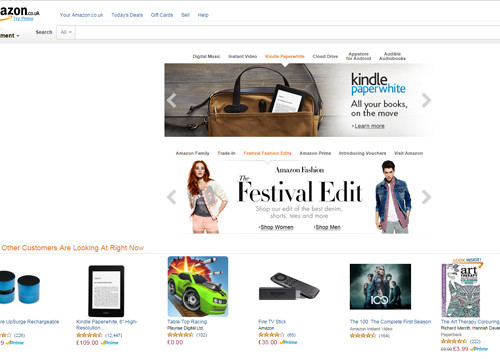With news that Amazon has opened a store on Alibaba’s online marketplace Tmall, as it seeks to expand in China, it is clear that external marketplaces are key for all companies big or small looking to reach new markets. In fact, recent research shows that 95% of UK retailers are already selling via online marketplaces with almost half using them to trade overseas. External marketplaces can offer a sales channel where retailers can benefit from the marketing, SEO strategy and payment structure of an often more established company. And for those looking to reach international markets, choosing a local marketplace can also offer help with potential cultural differences.
However, while external marketplaces can offer exciting new opportunities, they are not all the same and there are also challenges such as different delivery expectations and higher returns that need to be taken into consideration. So let’s examine some of the market leaders.
As might be expected, Amazon is the most popular site for UK sellers, with around 86% selling on the marketplace giant (followed by 68% on eBay). Amazon has more e-commerce sales than anyone else — an expected $91 billion in sales in 2014; more than the next dozen largest e-tailers combined. It seems that the global giant is now often the first port of call for shoppers and is even challenging the established search engine companies. The recent report by Forrester Research revealed that nearly one-third of online shoppers now begin to search for a product on Amazon, rather than using a search engine.
We use Amazon as an external marketplace for our sellers at Spreadshirt. For ecommerce retailers like us, an advantage of marketplaces is the wider reach they can offer. Becoming an Amazon Marketplace merchant gives our sellers another important route–to-market. It has become a vital part of our company’s increasingly multichannel distribution model. Best-selling products on the Spreadshirt platform are now automatically transferred to Amazon in key markets. In our experience Spreadshirt sellers on Amazon, have reported a doubling, sometimes tripling, in revenue. Our internal surveys show that, due to Amazon’s online traction, average sales can increase by up to 140%, with some larger brands experiencing on average an increase of up to 200%.
Amazon is clearly influential; driving reach and sales, but it is not the only marketplace out there. eBay now offers B2C routes and other, previously industry-only players such as the portal of U.S. company, Sears, are also entering the consumer market. While Amazon and eBay are the better known marketplaces in Europe, the US and Australia, if you look east towards Russia, or Asia, you come across other large, and locally very active, online marketplaces such as Ozon (Russia), Tmall (China) and Rakuten (Japan). All in their own way and in their regions, leading representatives.
Selling via one of these marketplaces could be a relatively risk-free way for UK companies to test new markets without huge investment. For example, companies looking at China, much like Amazon has, might take advantage of the Tmall marketplace. Selling through this marketplace means that retailers can operate in this market without investing in a local warehouse; however not being physically present may have an impact on delivery times, so expectations will need to be managed.
It is also important to bear in mind that not all online marketplaces are the same. Amazon makes it easy for the customer to make a quick purchasing decision. Other marketplaces, like Rakuten, focus more on the story. Here, sellers can be more individual, sharing stories with buyers and information on special features. Both approaches are noteworthy and offer different ways to present products.
There are clearly benefits of selling through external marketplaces, but likewise there are some challenges that need to be taken into account. For example, shipping and delivery expectations always need to be high on the list when considering expansion and new regions.
For us, one challenge on Amazon is that their customers expect very short delivery times. A particular problem for a print-on-demand platform competing with companies selling ready-made products. Despite having optimised production facilities in Europe, USA and South America, we still had to set up a separate business unit in order to meet new customer expectations on delivery times.
There is also the issue of higher returns rate on orders. On our site, where shoppers are more aware of the customisation and print-on-demand process, our returns are around just 3%. A downside of doing business on Amazon has been that our print-on-demand offering is not as well understood there. In external marketplaces, shoppers tend to order, try on at home, and send back for a refund if they don’t like it. This means that our returns are up, albeit to only 6%, which is still reasonable compared to industry standards.
Other challenges of new regions are getting the cultural fit right. External marketplaces can sometimes help with this, reducing to cost of cultural misunderstanding. Tmall even helps with advice on local fashions and trends.
In our experience, an external marketplace presence can certainly drive sales for retailers. However, companies need to also be prepared to deal with the challenges that all expansion into new channels and markets can bring. They need to consider which marketplace offers the right fit. Competition will always be fierce online, whatever your size, so it’s important to provide a shopping experience that offers customers more than just the lowest price tag. Marketplaces are bringing innovation and vitality to the online retail sector and offering a growing number of sellers a simple way to expand, an opportunity to test international markets and are even changing the way we shop. Our response has been to embrace external marketplaces, as they are helping develop both the online and multichannel markets, as well as preparing us for an increasingly multichannel future.






